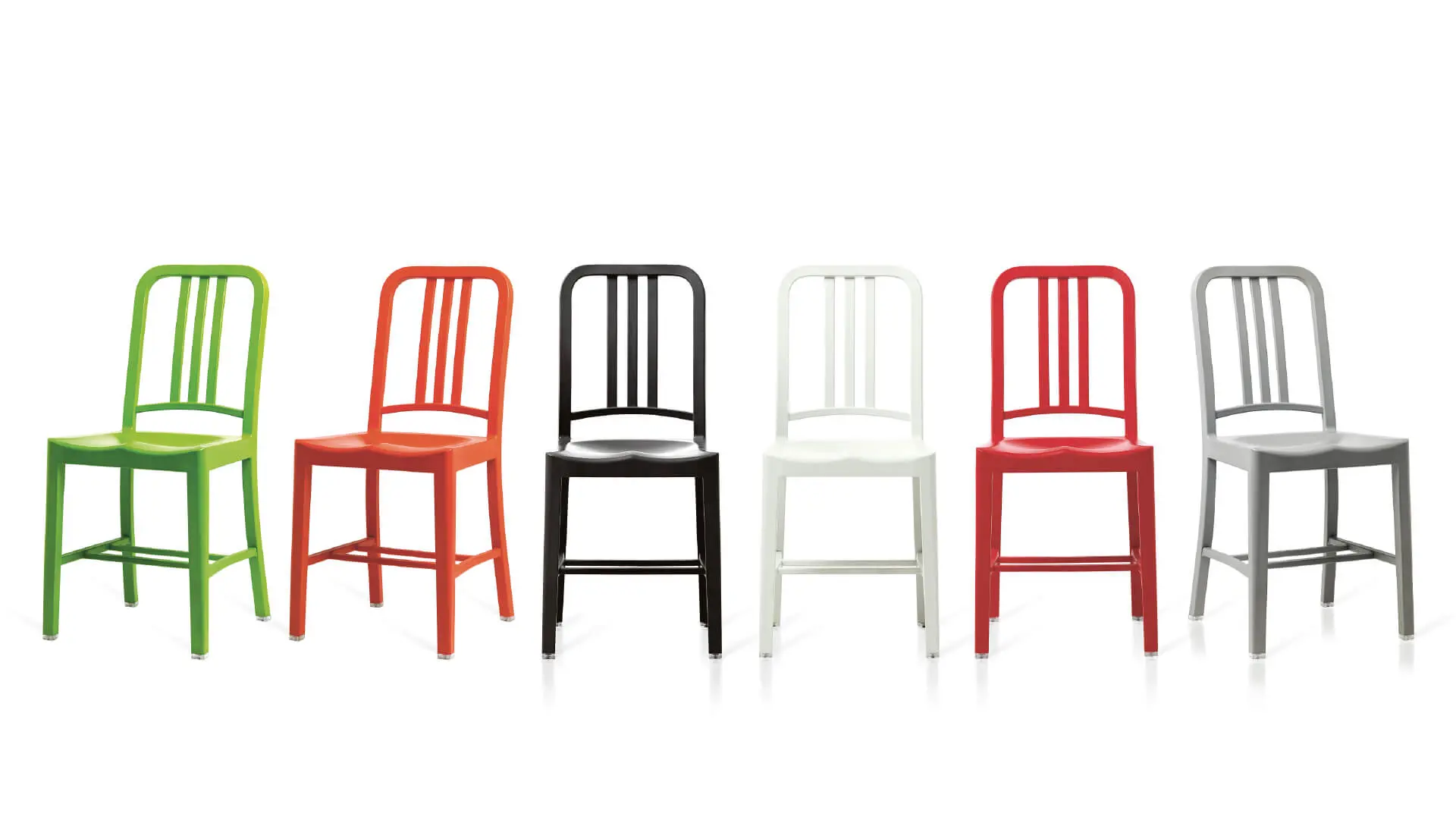Turning what’s left over into what will last with Emeco

Since its founding in 1944, Emeco has been creating beautiful, simple, and timeless products through sustainable practices and a commitment to minimize its impact on the environment.
Established in 1944 in the midst of World War II and with a government commission to create a chair to withstand the American Navy, Emeco designed the 1006 Navy Chair. Using a unique 77-steps process, recycled aluminium, and built to last a lifetime, the chair will become the DNA of every product Emeco will ever make.
Today, the push towards sustainability in design has been growing and it is hard for companies to ignore, but for Emeco, it has always been an essential and intrinsic part of their ethos. While companies all over the world are rethinking their processes to create more sustainable and environmentally friendly products, Emeco has always been a step ahead and collaborated with renowned designers over the years to create beautiful products that not only use recycled materials but are built to last.
Always with the goal to be as environmentally friendly as possible, Emeco continues to explore, research, and find solutions to protect our environment without compromising design, performance, or affordability. Amazed by their incredible commitment to sustainability and good design, DesignWanted had the opportunity to interview Emeco’s CEO Gregg Buchbinder and find out more about their design processes, sustainable practices, and what is next for this amazing American company.

How did the journey for Emeco begin?
Gregg Buchbinder: “During World War 2, due to a shortage of resources, Americans had salvage drives to support the war effort. Waste aluminium was collected and recycled to make the Emeco Navy Chair. The Navy Chair is made using 80% recycled aluminum and tested to last 150 years. That’s the bar we set for all the chairs we make and that was where the journey for Emeco began.”

Emeco has been making furniture for over 75 years. What makes your practice sustainable?
Gregg Buchbinder: “Our company’s foundation is built on our values. We are dedicated to building a sustainable future for our planet by making the best products we can. By “best” we mean products with long life using waste materials as our input.”

You have collaborated with some of the designers of our time. How do these relationships begin and how does Emeco research and experiment with sustainable solutions for their products?
Gregg Buchbinder: “Our relationships with designers begin with deep mutual respect, a commitment to producing great products, based upon our shared values, resulting in life-long friendships.
The internal product team at Emeco does ongoing engineering, research, and development for sustainability and longevity of materials – Life cycle analysis, life extension opportunities (repair), and end of life issues (recycling). With the 111 Navy Chair, we worked for 4 years on an innovative way to upcycle Coca-Cola’s waste rPET material.
After the 111 Navy Chair was launched, our work on the material continued, and after more than a decade of development, the material improved to a new level. This enabled us to make completely circular chairs. Our first new chair we launched using this circular material was On & On.”
Check out Philippe Starck’s design for Emeco, don’t miss Broom by Philippe Starck – A chair with a past, a present and a future!.

Emeco measures and declares the CO2 emissions of their products as a step to help reduce it. Can you tell us about this recent initiative and how it affects your design business?
Gregg Buchbinder: “We have been studying the best ways to measure our products, be as transparent as possible, and help inform consumers in an easy and understandable way. Our work with Doconomy and the carbon footprint calculator is fast, accurate, and inexpensive. This initiative affects our business in several ways.
Design at Emeco is more than what you see and how it functions, but it is inclusive of the material, packaging, energy use, and transportation. By measuring our carbon footprint we can see where our biggest impacts are coming from, and we take action to make further reductions.
Additionally, our design is about producing products that ‘deserve’ a spot in the world. By measuring carbon footprint, we are validating that for ourselves and our customers.”

Is the establishment of a sustainable furniture industry properly supported by institutions?
Gregg Buchbinder: “Sustainable furniture is supported by the most forward-thinking institutions. Some of these include education, technology, healthcare, and hospitality.”

Having vast experience in the field, in your opinion, how are manufacturers and consumers differently responsible when it comes to sustainable consumption?
Gregg Buchbinder: “A manufacturer is like a chef. They select all the ingredients and develop a process to make the product, or in the chef’s case, a recipe to cook the meal. Consumers may want to know the ingredients (what’s right for their diet,) and calories.
For products, consumers should know longevity (i.e.; warranty) and the actual carbon footprint. The more manufacturers provide this information, the more specifiers and regular consumers will be able to know what to ask for. The more that consumers ask, the more that manufacturers will include these ingredients. We think it is very important to normalize this disclosure of both calories- carbon footprint, and ingredients- materials.
Producers are able to achieve carbon neutral by purchasing carbon offsets to compensate for the carbon footprint of the product. Since any given product takes energy to produce, it is a bit misleading to say that a product is inherently ‘carbon neutral’.
However, the carbon offsets obscure the actual amount of carbon produced by any given process or material combination. Carbon Neutral is the goal- but disclosing the actual carbon footprint is very important for understanding any products’ actual impact.“

What can we expect from Emeco in the future?
Gregg Buchbinder: “We are currently consulting with some major brands on effective use and re-use of their waste materials. In addition, we are scaling our sustainability know-how on a zero-energy live-work restoration. It’s the preservation and adaptive reuse of a 1941 sewing shop.
Adaptive reuse stands as a method to cut back enormously on both the emissions and the construction and demolition waste. Everything was carefully considered – glazing, insulation, mechanical systems, passive energy, solar power & water heating, and natural ventilation.
We are always looking for ways to make a positive contribution to the environment and inspire others to join us in this cause.”
Find out more about companies that embrace sustainable practices through design, don’t miss noho is fighting against waste through beautiful design.





